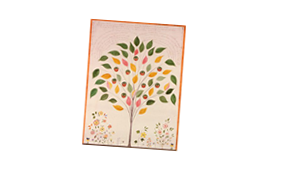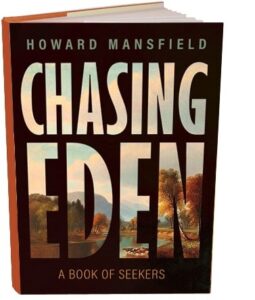CHASING EDEN: A BOOK OF SEEKERS
By Howard Mansfield
Bauhan Publishing (October 5, 2021)
ISBN: 978-0-87233-3505
From the first chapter
“No Good Is Ever a Failure.”
The Believers at Twilight
I. “An Honest Seeker.”
The summer that Bud Thompson met the Shaker sisters he was young and they were old. They had reached the country of old age and would be old for a very long time. They would come to be celebrated for being survivors, the last of their faith. They were photographed, recorded, and venerated for their age so much that it seemed like the sisters had been born as grandmothers in long, nineteenth- century dresses and bonnets. The sisters in their youth seemed like an impossibility. Old age became a mask, the way certain people are frozen with us in time—Einstein with his crazy white hair, W. H. Auden with his mud-cracked face, or Washington and Lincoln.
There were then, in the mid-1950s, fourteen Shaker sisters living at Canterbury in New Hampshire. The last brother had died in 1939. There had always been more Shaker women than men, all the way back to 1747, when the United Society of Believers in Christ’’s Second Appearing was founded in England and later brought to America by Mother Ann Lee. Their enemies had named them Shakers or “Shaking Quakers” for their ecstatic worship, for trembling and throwing themselves about and speaking in tongues. The days of trances and testifying, of “singing, dancing, shaking, shouting, leaping,” of nighttime worship so raucous, it could be heard for two miles—, those days were more than a century gone. They were no longer a threatening, radical religion. The Shakers Bud met were a quiet, pious, dedicated lot, their lives shaped by thousands of days of work and devotion into a work of art itself. The Canterbury sisters were living in the twilight of the Shaker utopia.
Life had portrayed Canterbury Shaker Village in 1949 as a waiting room for death, a few breaths shy of the next funeral. The black- and- white photos showed spare rooms with chairs hanging by pegs, the sisters looking dour in their long dresses and bonnets. The last page ended with the title “The Death of a Sect” and a big photo of a tombstone that said “Shakers.” No doubt, they were dead. A reader would have no idea of their daily joy, their sense of humor, their patience, and kindness. No. The entire article said: Dead end.
Bud was thirty-three years old, a big strapping guy with a broad smile and lively blue eyes. He was a traveling troubadour knocking around the West, booked into schools by an agent back East. Before that, at age sixteen, he was a singing cowboy with his own radio show, fifteen minutes a week on WMEX in Boston. He may have been the only teenaged singing cowboy from Rhode Island – and not even western Rhode Island – in the whole curious history of singing cowboys. After that, for a short time, he had a lady cowboy partner. They were billed as Babs and Bud.
He visited the three remaining Shaker villages at Canterbury, Sabbathday Lake, Maine, and Hancock, Massachusetts. At their peak in the mid-nineteenth century, there had been nineteen major Shaker communities and perhaps as many as six thousand Shakers. Bud was looking for new folk songs, but all the other local folk songs had been picked clean. Alan Lomax and other “songcatchers” were recording folk, blues, and jazz musicians in the field. Bud’s booking agent told him about the Shakers. They had written or adopted some ten thousand songs. The songs weren’t written, the Shakers said; they were received. This was the first Bud had heard of the Shakers.
He liked the three communities, but his Canterbury visit changed his life and the lives of the Shaker sisters. Walking around the village, he ran into Sister Lillian Phelps, and they got to talking quite a while about music. Lillian had studied music in school before she came to Canterbury at age sixteen. Lillian was very sick when she arrived. She had tuberculosis; her parents thought she would die. The sisters nursed her back to health. She decided to stay and seldom mentioned her illness, saying she had come for a summer vacation and fell in love with Canterbury. She loved to say that her vacation had lasted seventy years. Lillian played the organ – it had been bought with her in mind. She played every Sunday for the sisters and she gave music lessons. She was so moved by their meeting that she offered to play for Bud.
“They had this lovely Hook & Hastings organ” in the chapel, Bud recalled. Lillian played “Méditation” from Thaïs – “did a beautiful job”– and two or three other pieces. Then Lillian, who had “a little bit of teasing way about her,” said, “‘Now wait, Bud. We talked. We played a few things for you, and now we’’re expecting you to do something for us.’
“I said, ‘I don’t have my guitar. I don’t have any music.’
“‘Now, you’re not getting away with anything,’” Lillian said. “She was full of fun. She was a serious and smart lady, but she also had that kind of light. She had a beautiful personality.
“She lifts up the piano seat and she pulls out some schmaltzy thing like ‘The Bells of St. Mary,’ I think it was. So she played the accompaniment as I sang. I think we became almost instantaneous friends.”
Bud returned with his father, who sang in church and was a choir director. He had a comic routine where he’d deliver “Old Mother Hubbard” like a thundering, fire-and-brimstone preacher. The sisters loved it. They didn’t know when they’d laughed so hard.“We had a wonderful afternoon, and when we got done, Lillian and Sister Aida Elam said, ‘You know, Bud, we love you. We’ve got to get together more often. Can we do this again sometime?’”
Music had led Bud his whole life. Music led him to the Shakers and to his two wives. His first wife, Harriett, was an organist and choir director at a church, and his second, Nancy, was a soloist at another church. He fell in love with her when he heard her sing. His life was shaped by music.
Bud left to go sing out West, driving by himself from Hurley to Verona to Sarcoxie in Missouri, to Claremore and Nowata in Oklahoma, to West Mineral to Weir and Scammon in Kansas, to Carl Junction in Missouri, to Galena in Kansas, to Carthage, Alba, and Diamond, back in Missouri, singing some days at 9:00 a.m., 12:45 p.m., and 3:00 p.m., week after week, in small-town schools on a route that also took him to Iowa and Nebraska. But each Monday he’d get letters from Sister Lillian or Sister Bertha Lindsay. He had that to look forward to, a letter or two waiting for him in Rolla, Kansas (population 464), Hurley, Missouri (population 117), and all the other spots on the map where, at the end of the day, he knew no one. Bud had given them his schedule before he left. He saved the letters in a big photo album. Bud had given them his schedule before he left and the sisters pulled maps out of the drawers to follow his journey. He saved their letters in a big photo album.
This is the kind of devotion that happens in first love, with teens writing letters that cross town, the country, the seas. But this was the romance of an aging, celibate Christian order and a young man who sang cowboy songs and folk ballads.

